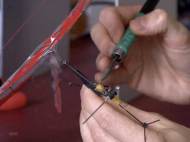Insects biomimicry for robots that hop, jump and stick
 We already wrote several articles regarding swarm robotics because it is offering innovative solutions to real-world problems by creating a new form of artificial intelligence based biomimicry of insect-like instincts. Mirko Kovac, from EPFL’s Laboratory of Intelligent Systems, is a robotics engineer who has already made leaps forward in the field with his grasshopper-inspired jumping robot and took that research a step further.
We already wrote several articles regarding swarm robotics because it is offering innovative solutions to real-world problems by creating a new form of artificial intelligence based biomimicry of insect-like instincts. Mirko Kovac, from EPFL’s Laboratory of Intelligent Systems, is a robotics engineer who has already made leaps forward in the field with his grasshopper-inspired jumping robot and took that research a step further.
He and his collaborators have created an innovative perching mechanism where the robot flies head first into the object without being destroyed during landing. After landing it is able to attach to almost any type of surface by using its sharp prongs. It then detaches on command. The goal is to create robots that can travel in swarms over rough terrain to come to the aide of catastrophe victims.
“We are not blindly imitating nature, but using the same principles to possibly improve on it,” explained Kovac. “Simple behavioral laws such as jumping, flying and perching lead to complex control over movement without the need for high computational power.”
Jumping, gliding and perching allow greater mobility over rocky territory or destroyed urban areas. This new form of AI takes its inspiration from the insect world, but is more as an abstract reflection on their instincts and design principles than merely imitating their morphology. This simplicity allows for greater mobility since the robots are not bogged down with heavy batteries.
The labs most recent innovation, perching a robot, saves valuable energy by allowing the robot to rest like insects or birds do. Many previous perching mechanisms include a complicated swooping maneuver to decrease momentum and land on legs, often without the ability of detaching. The mechanism avoids this problem by using two spring-loaded arms fitted with pins that dig into the surface, whether it is wood or concrete.
The snapping of the arms creates a forward momentum, allowing for a soft deceleration of the glider and avoiding mechanical damage. A remotely controlled mini-motor then detracts the pins and allows the robot to continue on its way.
“I am fascinated by the creative process,” said Kovac, “and how it is possible to use the sophistication found in nature to create something completely new.” The perching mechanism can be easily adapted to other robots. His previous robot, a quarter-gram jumping robot that can achieve heights of up to 1.4 meters (4.5 feet), could now be fitted with the new perching mechanism as well as wings, thus creating a hybrid creature that gets around much like a flying grasshopper.
Kovac imagines swarms of his robots equipped with different sensors and small cameras that could be deployed over devastated areas to transmit essential information back to rescue command centers. Who knows, we could see swarms of flying robots soaring into a blazing forest fire or other danger areas in near future. You can find more information in the research paper published in the Journal of Micro – Nano Mechatronics: “A perching mechanism for micro aerial vehicles”.









Great research.
Dr.A.Jagadeesh Nellore(AP),India